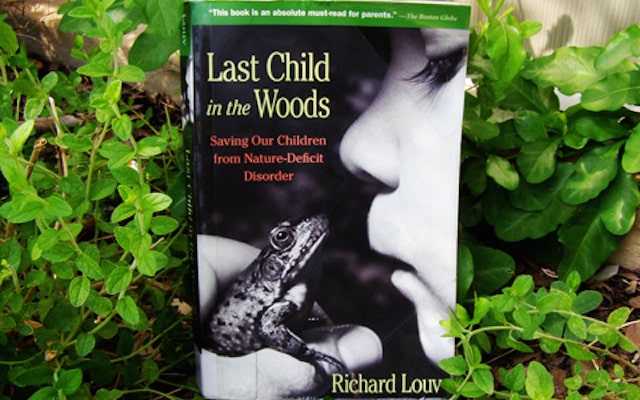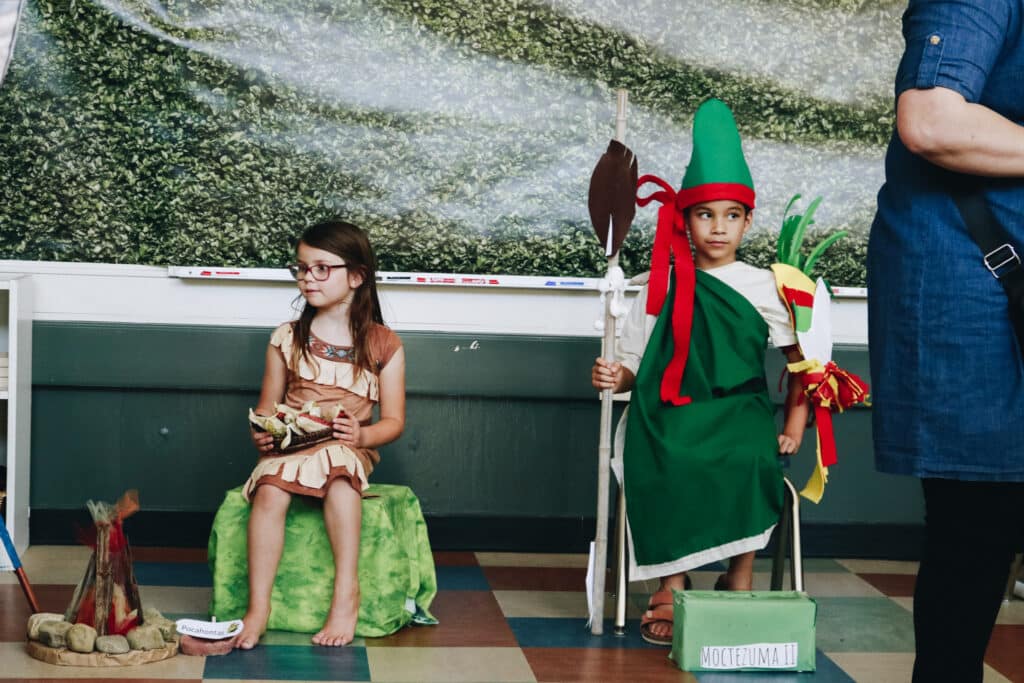
{image credit: waddlee-ah-chaa}
Welcome to another insightful edition of Pedagogic Ponderings! Spring is the perfect time to share to share the following review, and we hope you are both intrigued and inspired to add this book to your personal reading list:
Pedagogic Ponderings
Mrs. Burns’ Book Review Blog
Pedagogic Ponderings is a blog review of pedagogic (educational) books by our own Jenna Burns. After teaching History and Language Arts at SLOCA UMS for five years, Jenna is taking this year off of teaching to care for her new daughter, Julianna. But she is not taking a break from learning! She is seeking out the best books on education, reading them, pondering them, and reviewing them for us. In her blog she gives us a snapshot of the books and how their educational philosophies connect to what we are doing at SLOCA. We hope her blog helps you better understand classical education and our school.

This month I’m reviewing Last Child in the Woods: Saving our Children from Nature-Deficit Disorder by Richard Louv. I chose this book to review because in our modern times children are spending more and more time inside, and I wanted to hear the arguments for communing with nature. Though I’ve always enjoyed the outdoors and realized the importance of experiencing it, this book really inspired me to take some practical steps to bring nature into my everyday life. So, read this month’s blog to learn why there is a hole in Mrs. Burns’ backyard, discover the Boogeyman Syndrome, and understand how nature can enhance your child’s classical education.
Last Child in the Woods came to me at exactly the right time.
“I think she is bored,” I told my husband Brian, referring to a cranky Julianna surrounded by toys. “I know I am.” In the months following Julianna’s birth (I’m embarrassed to admit) I wasn’t getting out of the house (or my pajamas for that matter). It was time to get out of the rut, but what do you do with a baby all day long?
That’s when I started reading this book and I had my answer. “I’m going to take Julianna out in nature every day,” I told Brian. The results were unexpected. I saw first hand how nature can enrapture a child and I greatly benefited myself from the fresh air and beautiful surroundings. It was as Louv says in his book, nature is not only good for children it is good for parents as well.
Day one we went hiking at Reservoir Canyon. On our walk we felt dry, dead leaves that crackled and crumbled, velvety fresh clover that tickled, and bark-flecked twigs that snapped. The experience held her attention for so long, making me realize all her plastic toys that boast “sensory learning experiences” have nothing on nature. The sights, smells, sounds, and tastes (because, yes, Julianna tasted everything she could) were a varied and rich cornucopia. Here is a picture from the hike. She is just gorgeous, no?
{photo by Jenna Burns}
On day two of our nature outings Julianna ate Avila Beach. Well, just kidding, she left some sand for you to enjoy too. Later we went on a little family getaway to Monterey Bay. Here’s Julianna enjoying the view from Dad’s shoulders:
{photo by Jenna Burns}
We went to the SLO aquarium (AKA: Petco) to see fish and even brought some home. I’m proud to say our guppies, Ahab, Ishmael, and Queequeg, are still alive and swimming over a month later.
Next, we headed out to the local bird store. When the kind salesman tried to sell us a birdhouse specifically made to view birds from the comfort of your home I had to tell him twice, “I want to get a birdhouse that gets us out of the house and into nature.” It seemed to surprise him.
But the biggest change this book sparked is our backyard transformation project. What was once paving stones and gravel will soon be grass, flowering plants, a sunflower house, and . . . wait for it . . . a koi pond! Admittedly, right now all we have is one giant, ugly hole and a big ‘ol pile of dirt. (Anyone looking for some free dirt? Or some free exercise – digging works all the muscles, let me tell you!).
{photo by Jenna Burns}
Embarking on this back to nature process for my family has made me feel like somewhat of an outsider. As Julianna tasted a flower at the park a little girl tattled to her mother, “she has that in her mouth!” Later a friend remarked, “you don’t know what’s been sprayed on plants . . . or if they are poisonous.” (Admittedly, that is a very good point). The grandparents are pretty much convinced that putting in a pond guarantees our children will drown. When I explained the precautions we were taking and that we were putting in a retractable pool fence one friend asked, “Why don’t you put in a permanent fence to keep her away from the pond?” I tried to explain, “The whole point is to have her interact with nature.” In response I got one very blank face.
All this feedback left me a little shaken. The underlying well-intentioned message has been the same: Interacting with nature puts your children at risk, and a good mom protects her own from dangers. Out there they are in harm’s way and among forces beyond our control. Richard Louv calls this anxiety about nature the Boogeyman Syndrome. Granted, if being out in nature makes a child free than we must allow that with that freedom comes the possibility of accidents like falling out of a tree and breaking a leg, or getting poison oak, or drowning in a backyard koi pond, or a million other things.
So what’s the answer? Keep our children inside and in front of screens? I don’t think so, and I know you don’t either. So let me share with you the book that has inspired me, Last Child in the Woods by Richard Louv.
This book is a quick, easy read. Louv sprinkles his arguments with plenty of vivid stories, anecdotal evidence, and scientific studies. My favorite part of the book is the “100 Actions we can take” section, which is where I grabbed most of the activities I mentioned. Here are my three take-aways from the book:
- View nature experiences as one element of healthy development for your child. Louv’s book explores the many, many, health benefits of being in nature. For example, children that spend regular time in nature are less likely to be overweight and to be depressed. They are better able to cope with stress, are more imaginative in their thinking and play, and demonstrate greater ability to focus. We know this to be true because when we are in nature we feel it too. The calm. And we need more calm in our lives. As, in one of my favorite lines of poetry, William Butler Yeats says of nature, “And I shall have some peace there, for peace comes dropping slow.” Let’s let nature slow us down and give us a sense of peace. Parents who understand all the health benefits of nature will be more likely to make nature experiences a priority for their family.&nb
sp; As Louv points out, putting it in the healthy living column of our lives gives us permission to leave the Saturday chores undone and have a day at the beach. In other words, to have fun as a family! And we need more fun in our lives.
- To quote another poet, “Let nature be your teacher,” (William Wordsworth). Yes, there are real dangers outside, but Louv sees them as an opportunity to teach children to pay attention. Let’s show them what poison oak looks like, or how to spot the tracks of a mountain lion. Children need to know about strangers and whom they can trust. Such practices can build self-esteem and confidence. It empowers the child instead of transmitting to them the message of the Boogeyman Syndrome, which is born of fear and paranoia.
- Experiences in nature connect us. I had my secret hiding place as a child, did you? Evergreen shrubs reached out over my best friend Jessica’s lawn like big feathery fingers. Everyday after school we would navigate deep into their recesses where we fancied ourselves quite hidden and in our own special world. It’s why I’m planting a sunflower house in the backyard. I want Julianna to have her own magical hideaway. I treasure my childhood memories of camping in the redwoods. It’s why I can’t wait to take Julianna camping this May. Out in nature we bond with our past. We bond with one another. We bond with the land. This is one of those slippery, perhaps idealistic arguments for spending time in nature. The benefit can’t quite be measured and isn’t always immediately evident. Yet, we can probably all agree with Louv’s remark: “The times I spent with my children in nature are amongst my most meaningful memories – and I hope theirs,” (316). Let’s get out there and make some memories!
/sunflowerhouse.jpg)
{image credit: Erica Story for San Juan Parent}
So what does this book have to do with education and how does it relate to what we are doing at SLOCA?
All educators know of Howard Gardner and his theory of multiple intelligences: children learn best in different ways. For example, some learn best when they can get up and move (bodily-kinesthetic), and some when they can talk it out with others (interpersonal). Arguably, the best education for every student is the one that addresses all the types of intelligences. What some of us don’t know is that recently Gardner added an eighth intelligence: naturalist intelligence, or nature smart. Louv highlights that this gives credence to the notion that nature is a vital part of learning for all students, and for some more than others. Here are a few examples of what education in nature could look like.
Your child doesn’t like Hamlet? Wait for a foggy night. Venture outside and reread scene one by flashlight. Does the ghost come alive under the starlight? Or bury a (plastic) skull in the sandbox. After your child discovers it recite the famous “Alas, poor Yorick” speech. Does that make Shakespeare more fun?
Your child isn’t understanding mathematical patterns? Go outside and pick flowers to discover the Fibonacci sequence. Building a treehouse has thirteen different educational lessons, points out Louv, including learning about measurements and three-dimensional geometry, (82). Our backyard pond has required plenty of math, which thankfully my husband has handled.
/treehouse.jpg)
(image source: Home Stratosphere}
So we see that nature can enrich education. To take that a step further, the outdoor classroom is a classical notion in my opinion. I think of Socrates teaching in the marketplace. What living examples did he point out to his students there? Would not his conversations have been truncated if they had taken place indoors?
Nature is somewhat limited on the SLOCA campus. I look forward to when we have our own land and can build nature playscapes and outdoor classrooms. However, from reading poetry outside to collecting science specimens around campus, SLOCA teachers are being mindful to include nature in their schooldays. But the greatest opportunity for education in nature is on our home days. Here’s my challenge to you: spend 30 minutes reading aloud to your child in nature on your home days. Head out to the backyard, the park, the beach, or the woods. Lay down a comfy blanket and break out the book. See if over time your child seems to benefit from the fresh air and change of scenery. Share with us your experiences and your favorite outdoors spots in the comments section below!
“Nature is imperfectly perfect, filled with loose parts and possibilities, with mud and dust, nettles and sky, transcendent hands-on moments and skinned knees,” (97). Here’s to muddy pants, possibilities, and skinned knees! Here’s to nature!
/boyhiking.jpg)
{image credit: Kindred Media}
Louv, Richard. Last Child in the Woods: Saving our Children from Nature-Deficit
Disorder. Algonquin Books: Chapel Hill, 2008. Print.
Coming up next: Play: How it shapes the brain, opens the imagination, and invigorates the soul by Dr. Stuart Brown. Since Julianna came along, I’m increasingly interested in the relationship between learning and play. I can’t wait to dive into this book to learn more and share my findings with you!

This books sounds fantastic! Thank you Jenna, for taking the time to not only read and review this excellent resource for us, but also for applying its wisdom to your own life, schedule, and backyard! You have inspired us to do the same. Readers, as mentioned above, if you have a favorite outdoor spot to share, or ideas for incorporating more nature into your routine, please post them in the comments!
Other reviews in this series:
The Read-Aloud Handbook by Jim Trelease
Ten Ways to Destroy the Imagination of your Child by Anthony Esolen
The Well-Trained Mind by Susan Wise Bauer and Jesse Wise
The Core by Leigh A. Bortins
How to Teach Your Children Shakespeare by Ken Ludwig
Climbing Parnassus by Tracy Lee Simmons
Play: How it Shapes the Brian, Opens the Imagination, and Invigorates the Soul by Dr. Stuart Brown
SLO Classical Academy is not affiliated with any of the above mentioned websites or businesses.











